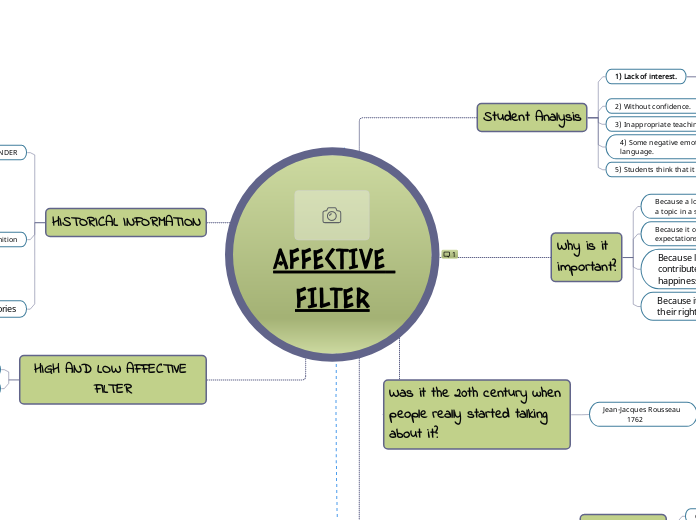
AFFECTIVE FILTER
Student Analysis
1) Lack of interest.
Diferent proyects of life
They don't like study
2) Without confidence.
Personality
3) Inappropriate teaching method of the teacher.
Traditional method
4) Some negative emotions against the target language.
Something related to the past
5) Students think that it is useless to learn.
Why is it
important?
Because a low filter allows students to understand a topic in a satisfactory way.
Because it could allow them to exceed the learning expectations of the classroom.
Because lowering the affectivity filter contributes to children's self-esteem and happiness.
Because it allows children to fully enjoy their right to a quality education.
Was it the 20th century when people really started talking about it?
Jean-Jacques Rousseau
1762
He was at the same time a writer, pedagogue, philosopher, musician, botanist and naturalist. He wrote about kids
The philosophy of education
"EL EMILIO"
"DE LA EDUCACIÓN"
"The desire"
He talked about the fact that the teacher should be a guide in the learning of his students.
And the first thing that the teacher should develop in them is "the desire to learn".
- The nature of the child is curious. The game is what he likes the most.
- Put the problems within his reach and let him solve them.
Curious truths
Children learn freely.
They have a natural motivation.
The main motivation is to educate knowing for the sake of knowing.
HISTORICAL INFORMATION
THE FOUNDER
Dulay y Burt (1977)
- Integrative motivation
You want
- Instrumental motivation
Pass an exam
Stephen Krashen
- learning (mechanic)
- acquisition (free)
1986
The first definition
Imaginary wall in the mind and prevents entry of information, thus blocking cognition.
SIMPLE WORDS: The affective filter acts as a barrier to acquisition.
3 categories
Motivation
Self confidence
Anxiety
HIGH AND LOW AFFECTIVE FILTER
High A.F
negative
Low A.F
positive
How do we lower the affective filter in the classroom?
providing
a good educational
service
that includes
everything
Motivation
Give students extrinsic motivation.
D: WHEN "The individual works or strives to learn the language due to the desire and satisfaction experienced in this activity".
Anxiety or
Fear of communication
Students should not be afraid of making mistakes.
Work on giving them appropriate body language.
sit next to a student to talk to him
NOT: sit in front of him
threat
unnecessary authority
D: Test anxiety. Fear of negative
evaluation by others
The students can become friends
Self confidence
Generate in them a sense of belonging, value and respect for their individuality
FREEDOM
Investigate their family situations to get to know them more than just students, to get to know them as humans.
The attitude
Attitude decides commitment
Attitude influences participation in class.
Learners with a positive attitude tend to learn L2 easily
